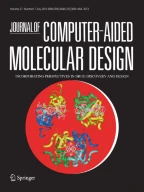Abstract
Molecular dynamics (MD) and molecular docking are commonly used to study molecular interactions in drug discovery. Most docking approaches consider proteins as rigid, which can decrease the accuracy of predicted docked poses. Therefore MD simulations can be used prior to docking to add flexibility to proteins. We evaluated the contribution of using MD together with docking in a docking study on human cathepsin B, a well-studied protein involved in numerous pathological processes. Using CHARMM biomolecular simulation program and AutoDock Vina molecular docking program, we found, that short MD simulations significantly improved molecular docking. Our results, expressed with the area under the receiver operating characteristic curves, show an increase in discriminatory power i.e. the ability to discriminate active from inactive compounds of molecular docking, when docking is performed to selected snapshots from MD simulations.
Similar content being viewed by others
References
Barrett AJ (1981) Cathepsin B, cathepsin H, and cathepsin L. Meth Enzymol 80:535–561
Hook V, Toneff T, Bogyo M et al (2005) Inhibition of cathepsin B reduces β-amyloid production in regulated secretory vesicles of neuronal chromaffin cells: evidence for cathepsin B as a candidate β-secretase of Alzheimer’s disease. Biol Chem 386:1325
Mohamed MM, Sloane BF (2006) Cysteine cathepsins: multifunctional enzymes in cancer. Nat Rev Cancer 6:764–775
Illy C, Quraishi O, Wang J et al (1997) Role of the occluding loop in cathepsin B activity. J Biol Chem 272:1197–1202
Almeida PC, Nantes IL, Chagas JR et al (2001) Cathepsin B activity regulation heparin-like glycosaminoglycans protect human cathepsin B from alkaline ph-induced inactivation. J Biol Chem 276:944–951
Mirković B, Renko M, Turk S et al (2011) Novel mechanism of cathepsin B inhibition by antibiotic nitroxoline and related compounds. ChemMedChem 6:1351–1356
Sosič I, Mirković B, Arenz K et al (2013) Development of new cathepsin B inhibitors: combining bioisosteric replacements and structure-based design to explore the structure–activity relationships of nitroxoline derivatives. J Med Chem 56:521–533
Ripphausen P, Nisius B, Peltason L, Bajorath J (2010) Quo vadis, virtual screening? A comprehensive survey of prospective applications. J Med Chem 53:8461–8467
Sastry GM, Adzhigirey M, Day T et al (2013) Protein and ligand preparation: parameters, protocols, and influence on virtual screening enrichments. J Comput Aided Mol Des 27:221–234
Scior T, Bender A, Tresadern G et al (2012) Recognizing pitfalls in virtual screening: a critical review. J Chem Inf Model 52:867–881
Huang N, Shoichet BK, Irwin JJ (2006) Benchmarking sets for molecular docking. J Med Chem 49:6789–6801
Mysinger MM, Carchia M, Irwin JJ, Shoichet BK (2012) Directory of useful decoys, enhanced (DUD-E): better ligands and decoys for better benchmarking. J Med Chem 55:6582–6594
Nichols SE, Baron R, Ivetac A, McCammon JA (2011) Predictive power of molecular dynamics receptor structures in virtual screening. J Chem Inf Model 51:1439–1446
Trott O, Olson AJ (2010) AutoDock Vina: improving the speed and accuracy of docking with a new scoring function, efficient optimization, and multithreading. J Comput Chem 31:455–461
O’Boyle NM, Morley C, Hutchison GR (2008) Pybel: a Python wrapper for the OpenBabel cheminformatics toolkit. Chem Cent J 2:5
O'Boyle NM, Banck M, James CA et al (2011) Open Babel: an open chemical toolbox. J Cheminf 3:33
Landrum G (2006) RDKit: open-source cheminformatics. (Online). http://www.rdkit.org. Accessed 03/04/2012
Brooks BR, Brooks CL, MacKerell AD et al (2009) CHARMM: the biomolecular simulation program. J Comput Chem 30:1545–1614
Jorgensen WL, Chandrasekhar J, Madura JD et al (1983) Comparison of simple potential functions for simulating liquid water. J Chem Phys 79:926–935
Janežič D, Venable RM, Brooks BR (1995) Harmonic analysis of large systems. III. Comparison with molecular dynamics. J Comput Chem 16:1554–1566
Schaftenaar G, Noordik JH (2000) Molden: a pre-and post-processing program for molecular and electronic structures*. J Comput Aided Mol Des 14:123–134
Vanommeslaeghe K, Hatcher E, Acharya C et al (2010) CHARMM general force field: a force field for drug-like molecules compatible with the CHARMM all atom additive biological force fields. J Comput Chem 31:671–690
Vanommeslaeghe K, MacKerell AD Jr (2012) Automation of the CHARMM General Force Field (CGenFF) I: bond perception and atom typing. J Chem Inf Model 52:3144–3154
Vanommeslaeghe K, Raman EP, MacKerell AD Jr (2012) Automation of the CHARMM General Force Field (CGenFF) II: assignment of bonded parameters and partial atomic charges. J Chem Inf Model 52:3155–3168
Humphrey W, Dalke A, Schulten K (1996) VMD: visual molecular dynamics. J Mol Graph 14:33–38
Karaboga AS, Petronin F, Marchetti G et al (2013) Benchmarking of HPCC: a novel 3D molecular representation combining shape and pharmacophoric descriptors for efficient molecular similarity assessments. J Mol Graph Model 41:20–30
Borštnik U, Hodošcek M, Janezic D (2004) Improving the performance of molecular dynamics simulations on parallel clusters. J Chem Inf Comput Sci 44:359–364
Congreve M, Carr R, Murray C, Jhoti H (2003) A “rule of three”for fragment-based lead discovery? Drug Discov Today 8:876–877
Author information
Authors and Affiliations
Corresponding author
Electronic supplementary material
Below is the link to the electronic supplementary material.
Rights and permissions
About this article
Cite this article
Ogrizek, M., Turk, S., Lešnik, S. et al. Molecular dynamics to enhance structure-based virtual screening on cathepsin B. J Comput Aided Mol Des 29, 707–712 (2015). https://doi.org/10.1007/s10822-015-9847-2
Received:
Accepted:
Published:
Issue Date:
DOI: https://doi.org/10.1007/s10822-015-9847-2
